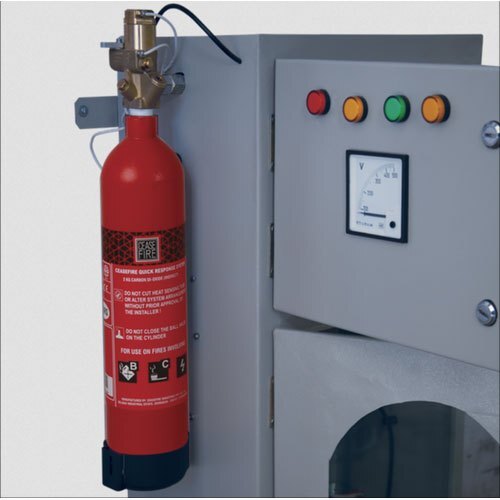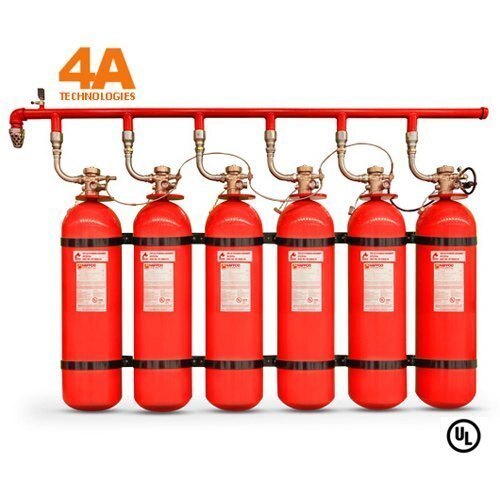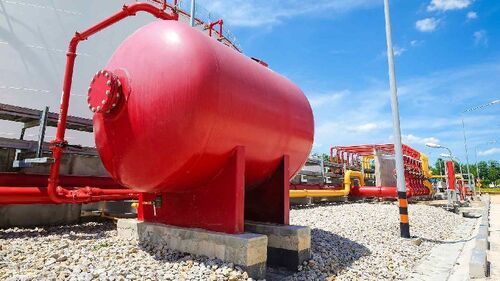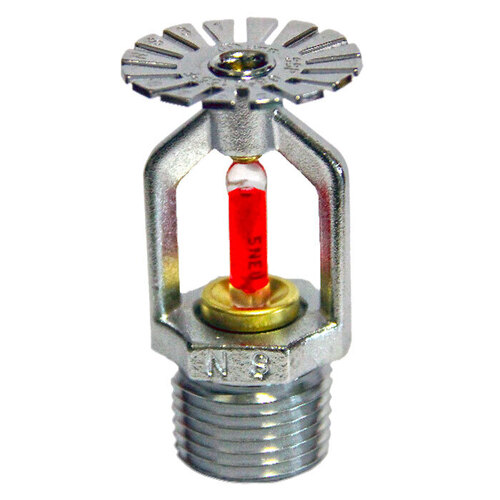- Home Page
- Company Profile
-
Our Products
- Fire Suppression Systems
- FK 5112 Suppression System
- Clean Agent Cylinderless System
- Clean Agent Cylinderless System for Car
- Wind Turbine Fire Detection and Suppression System
- Vehicle Fire Protection System
- Mild Steel Novec 1230 Fire Suppression System
- Fire Extinguishing System For Electrical Cabinets
- Aerosol Fire Suppression System
- Novec 1230 Flooding System
- Hfc 227ea Based Fire Suppression System
- Modular Clean Agent HFC236fa Extinguishers
- Aerosol Based Fire Suppression System
- FM200 Fire Suppression System
- Cylinder Less Tube Based Fire Detection Suppression Systems
- High Voltage Transformer Fire Suppression System
- Hfc227ea Clean Agent Fire Extinguishers
- Novec 1230 Clean Agent Suppression Systems
- Carbon Steel Fm 200 Fire Suppression System
- Direct Tube Based Fire Suppression System
- Novac 1230 Fire Flooding Systems
- Clean Agent Fire Suppression System
- Hfc 227ea Auto Fire Extinguishing System
- Car Fire Protection System
- Fire Suppression For Power Generators
- Hfc227ea Total Flooding System
- Dual Agent Retardant fire Suppression System
- Heat Sensing Tube
- Clean Agent Fire Suppression System for Wind Turbine
- Bus Engine Fire Protection System
- Fire Trace System
- Novec 1230 Fire Suppression System
- SEVO Tubing Suppression System
- Fire Detection And Fire Suppression System
- Heavy Vehicle Fire Suppression Systems
- Fire Sprinkler System Installation Service
- Vehicle Fire Suppression System
- Pre Engineered Fire Suppression System
- Server Rack Fire Suppression System
- Mild Steel Fire Suppression Systems
- Fire Suppression System (Capacitor Panel)
- Electrical Panel Detection Suppression System
- Fire Detection Tube Suppression System
- Fire Extinguishing System For Electrical Panel
- Electrical Panel Gas Suppression System
- Novec 1230 Fire Suppression System for Industrial
- Fm200 Gas Based Fire Suppression Systems
- FM200 Gas Based Fire Suppression Systems For Wind Turbines
- Tube Based Fire Suppression System
- Novec 1230 Fire Gas Suppression System For Electrical Panel
- Novec 1230 Fire Extinguishing System
- Novec 1230 Gas Suppression System For Wind Turbine Fire Suppression System
- Nitrogen Injection Transformer Fire Protection System
- Electrical Panel Fire Suppression System
- Dual Agent Retardant Fire Suppression System
- Diffusible FE36 Fire Suppression System
- Hazardous Cabinets Fire Suppression System
- Chemical Fire Suppression Systems
- Nitrogen NITFP System
- Automatic Fire Detection and Suppression System
- Novec 1230 Fire Suppression Systems
- Fire Suppression For Wind Turbines
- Bladder Tank Proportioning System
- Electrical Panel Fire Suppression
- Fk 5112 Fire Suppression System
- Fire Extinguishing Systems
- Fire Alarms And Detection Systems
- White Addressable Duct Detector
- UV IR Flame Detector
- Agni Sounder Hooter
- Addressable Fire Alarm System
- Fire Alarm System Amc Service
- Conventional Fire Alarm System
- Digital Addressable Fire Alarm System
- Aspirating Systems Smoke Detectors
- Agni Addressable Security Fire Alarm
- Fire Detection And Fire Alarm System
- Uv Ir Flame Detector System
- Ravel 2 zone Conventional Fire Alarm System
- Addressable Photoelectric Duct Detector
- Fire Alarm Sounder
- Fire Response Indicator
- Vesda Aspirating Smoke Detection System
- 4 Zone Addressable Fire Alarm System
- Ravel 4 zone Conventional Fire Alarm System
- Fire Detection Fire Alarm System
- Co2 Flooding/Suppression System
- High Pressure Co2 Automatic Fire Extinguishing System
- Co2 Gas Fire Suppression System
- CO2 Suppression System
- CO2 Fire Flooding
- ELECTRICAL PANEL CO2 FLOODING SYSTEM
- Automatic Pipeline Co2 Fire Suppression System
- Co2 Fire Flooding System
- Co2 Cylinder Fire Suppression System
- In Direct CO2 Flooding System
- Co2 Based Fire Suppression Systems
- Automatic Co2 Flooding System
- Automatic CO2 Flooding System
- Gas Based Co2 Flooding System
- Automatic Pipeline CO2 Fire Suppression System
- Co2 Fire Suppression System
- Passive Fire Protection
- Fire Extinguishers
- Twin Trolley Type Fire Extinguisher
- Co2 Fire Extinguisher Refilling Service
- Clean Agent Type Fire Extinguisher
- Amc For Fire Fighting System
- Co2 type fire Extinguisher
- Mild Steel Wet Chemical Fire Extinguisher
- Carbon Steel Abc Fire Extinguisher
- Automatic Ceiling Mounted D Type Fire Extinguisher
- Water Spray Sprinkler Systems
- Kanex Fire Extinguishers
- Fe36 Clean Agent Fire Extinguisher
- Modular Dry Chemical Powder Extinguishers
- Kitchen Fire Suppression System
- Kitchen Fire Suppression System
- Mild Steel Kitchen Fire Suppression
- Kitchen Hood Fire Suppression System
- Automatic Kitchen Fire Extinguishing System
- Kitchen Fire Extinguisher
- kitchen Nozzle Fire Suppression System
- Restaurant Kitchen Fire Suppression System
- Fire Suppression System For Commercial Kitchen
- Commercial Kitchen Fire Suppression System
- HW & MV Fire Protection System
- Commercial Gas Leak Detector
- Medium Velocity Water Spray System (MVWS)
- Transformer Fire Protection System
- Transformer Fire Prevention System
- Transformer Fire Suppression Systems
- Conveyor belt system fire protection system
- Nitrogen Injection Fire Protection System For Transformer
- High Velocity Water Spray System (HVWS)
- Fire Suppression Accessories
- Fire Hydrant System
- Clean Agent Gas Refilling
- Fire Fighting Foams
- Smoke Detector
- Ravel Beam Smoke Detector
- Addressable Photoelectric Smoke Detector
- Addressable Smoke Detector
- Fire Alarm Addressable Smoke Detector
- Battery Addressable Smoke Detector
- Polycarbonate Smoke Detector
- Agni Smoke Detector
- Conventional Optical Smoke Detectors
- Addressable Duct Smoke Detector
- Agni Wireless Smoke Detector
- White Polycarbonate Smoke Detector
- Manual Call Point
- Fire Retardant Fabric
- Fire Alarm Control Panel
- Heat Detector
- Beam Detectors
- Fire Door
- HW&MV Fire Protection
- Fire Cable Coating
- Fire Cable
- Public Address Systems
- Hydraulic Hose
- Fire Suppression Systems
- Contact Us

Fire Trace System
40000 INR/Piece
Product Details:
- Usage FIRE SUPPRESSION SYSTEM FOR ELECTRICAL PANEL
- Weight KG Kilograms (kg)
- Input Power WATT Watt (W)
- Dimension (L*W*H) METER Meter (m)
- Product Type FIRE SUPPRESSION SYSTEM
- Color RED
- Warranty 1 YEARS
- Click to view more
X
Fire Trace System Price and Quantity
- 40000 INR/Piece
- 1 Piece
Fire Trace System Specification
- 1 YEARS
- FIRE SUPPRESSION SYSTEM FOR ELECTRICAL PANEL
- CELSIUS Celsius (oC)
- YES
- M.S
- HZ Hertz (HZ)
- KG Kilograms (kg)
- WATT Watt (W)
- FIRE SUPPRESSION SYSTEM FOR ELECTRICAL PANEL
- FIRE SUPPRESSION SYSTEM
- RED
- METER Meter (m)
Fire Trace System Trade Information
- Cheque
- 100 Piece Per Month
- 10 Days
- Yes
- Free samples available with shipping and taxes paid by the buyer
- LOT
- Asia
- All India
- ISO & CE CERTIFICATE
Product Description
A Fire Trace System, also known as a fire suppression system or automatic fire suppression system, is a specialized safety system designed to detect and extinguish fires in various environments, such as industrial facilities, server rooms, commercial kitchens, and more. It is particularly valuable in situations where traditional fire sprinkler systems may not be suitable or where sensitive equipment or materials need protection.
Fire Trace System Advantages:
1. Quick Response: Fire Trace Systems are designed for rapid detection and immediate response to fires. They can detect fires at an early stage, minimizing the time it takes to initiate suppression, which can be crucial in preventing the fire from spreading and causing extensive damage.
2. Automatic Operation: These systems operate automatically once a fire is detected, eliminating the need for human intervention. This ensures that fires are addressed promptly, even if there are no personnel present, which is especially important in unmanned or remote locations.
3. Localized Protection: Fire Trace Systems are often designed to provide localized protection. They target the specific area where the fire is detected, minimizing damage to nearby equipment or materials that may not be involved in the fire.
4. Minimal Damage: Unlike traditional water-based sprinkler systems, Fire Trace Systems use clean agents or dry chemicals that leave minimal residue and cause little to no damage to sensitive equipment, electronics, or valuable assets. This can result in lower cleanup and repair costs.
5. Compatibility: These systems can be customized to suit various applications and environments, making them versatile and adaptable. They are commonly used in server rooms, data centers, industrial machinery, electrical cabinets, and more.
6. Environmental Considerations: Some Fire Trace System suppression agents, such as clean agents like FM-200 or Novec 1230, are environmentally friendly and have a low global warming potential. They do not contribute to ozone depletion, making them a responsible choice for fire suppression.
7. Safety: Fire Trace Systems are designed with safety in mind. They minimize the risk to personnel by automatically suppressing fires, reducing the need for individuals to enter potentially hazardous areas to fight fires manually.
8. Regulatory Compliance: Many industries and applications require compliance with specific fire safety standards and regulations. Fire Trace Systems can be designed and installed to meet these standards, helping organizations adhere to legal requirements.
9. Maintenance: Regular maintenance and testing of Fire Trace Systems ensure their continued reliability. Routine inspections can identify any issues or problems and address them before they impact system performance.
10. Flexibility: These systems can be configured with various types of detection sensors, suppression agents, and release mechanisms to suit the specific needs and risks of different applications.
11. Cost-Effective: While the initial installation cost of Fire Trace Systems may be higher than traditional sprinkler systems, the potential savings in terms of reduced damage, cleanup, and business interruption costs can make them cost-effective over the long term.
FAQ:
Q. What is a Fire Trace System?
Ans: A Fire Trace System is a specialized fire suppression system designed to detect and suppress fires automatically in various environments. It uses a combination of detection sensors and suppression agents to quickly respond to fire incidents.
Q. How does a Fire Trace System work?
Ans: These systems typically consist of detection sensors (heat, flame, or smoke detectors), a network of pipes and nozzles filled with a suppression agent, and a release mechanism. When a fire is detected, the system activates the release mechanism, allowing the suppression agent to be discharged into the affected area to extinguish the fire.
Q. What types of detection methods are used in Fire Trace Systems?
Ans: Fire Trace Systems primarily use heat and flame detectors to sense temperature increases or the presence of flames. Some systems also incorporate smoke or gas detectors for additional sensitivity.
Q. What types of suppression agents are used in Fire Trace Systems?
Ans: Common suppression agents include clean agents like FM-200, CO2, and dry chemical powders. The choice of suppression agent depends on the specific application and the materials being protected.
Q. Where are Fire Trace Systems commonly used?
Ans: Fire Trace Systems are used in a wide range of applications, including server rooms, data centers, industrial machinery, electrical cabinets, commercial kitchens, and manufacturing facilities.
Q. What are the advantages of Fire Trace Systems?
Ans: Advantages include quick response, automatic operation, localized protection, minimal damage, compatibility with sensitive equipment, environmental considerations, safety, regulatory compliance, flexibility, and cost-effectiveness.
Q. How often should Fire Trace Systems be maintained?
Ans: Regular maintenance is essential to ensure the systems reliability. Maintenance typically includes inspections, testing of detection sensors, and verification of all system components to ensure they are in good working order. Frequency may vary depending on local regulations and manufacturer recommendations.
Q. Are there environmental concerns with Fire Trace Systems?
Ans: Some suppression agents used in Fire Trace Systems, like clean agents (e.g., FM-200 or Novec 1230), have a low environmental impact and do not contribute to ozone depletion. They are considered environmentally friendly.
Q. Do Fire Trace Systems comply with safety standards and regulations?
Ans: Yes, Fire Trace Systems can be designed and installed to meet specific industry and regulatory standards to ensure they are safe and effective in protecting life and property.
Q. How do Fire Trace Systems compare to traditional sprinkler systems?
Ans: Fire Trace Systems offer advantages such as minimal damage, quick response, and suitability for sensitive equipment, whereas traditional sprinkler systems use water, which can cause significant damage to property and may not be suitable for all environments.
Q. Can Fire Trace Systems be retrofitted into existing facilities?
Ans: Yes, Fire Trace Systems can often be retrofitted into existing facilities, but the feasibility and ease of installation depend on the specific facility and its layout.
Q. Do Fire Trace Systems require electricity to operate?
Ans: Some components, like detection sensors and release mechanisms, may require electrical power. However, many systems are designed with redundancy and backup power sources to ensure they operate reliably in the event of a power failure.
FAQs of Fire Trace System:
Q: What is the input power for Fire Trace System?
A: The input power for Fire Trace System is WATT Watt (W).Q: What is the temperature range for Fire Trace System?
A: The temperature range for Fire Trace System is CELSIUS Celsius (oC).Q: What is the warranty period for Fire Trace System?
A: The warranty period for Fire Trace System is 1 year.Q: What is the color of Fire Trace System?
A: The color of Fire Trace System is RED.Q: What is the application of Fire Trace System?
A: The application of Fire Trace System is fire suppression system for electrical panel.Tell us about your requirement

Price:
Quantity
Select Unit
- 50
- 100
- 200
- 250
- 500
- 1000+
Additional detail
Mobile number
Email
Other Products in 'Fire Suppression Systems' category
" We mainly want inquiries from Gujarat, Rajasthan, Madhya Pradesh, Maharashtra, Goa. "







 English
English Spanish
Spanish French
French German
German Italian
Italian Chinese (Simplified)
Chinese (Simplified) Japanese
Japanese Korean
Korean Arabic
Arabic Portuguese
Portuguese